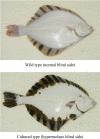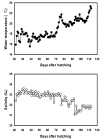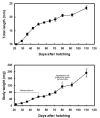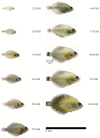Morphological Analysis of Blind-Side Hypermelanosis of the Starry Flounder, Platichthys stellatus during Early Development
- PMID: 25949175
- PMCID: PMC4282256
- DOI: 10.12717/DR.2014.18.2.079
Morphological Analysis of Blind-Side Hypermelanosis of the Starry Flounder, Platichthys stellatus during Early Development
Abstract
In Pleuronectiformes, blind-side malpigmentation (hypermelanosis) is common in cultured flatfishes, and is economically important. To understand the mechanism of blind-side hypermelanosis in flatfishes, we examined when the malpigmentation initially occurred, and studied how the symptoms proceeded during early development of the starry flounder, Platichthys stellatus. To assess quantitative pattern changes of blind-side skin, we observed morphological development of the whole body from 22 (total length [TL] 10.0±0.2 mm and body weight [BW] 8.8±0.57 mg) to 110 days (TL 23.4±0.7 mm, BW 193.6±23.3 mg) after hatching (DAH), and also examined the malpigmented area rate of blind-side skin and the malpigmented fish ratios. The experimental animals were reared in fiberglass-reinforced plastic (FRP) tanks in water at a temperature of 18.9±1.9°C and salinity of 32.6±0.6 psu and were fed with rotifer and Artemia nauplii from 22 to 48 DAH, and with A. nauplii and commercial feed from 49 to 110 DAH. As results, the first staining patch seen by the naked eye was observed around the area between the anus and pelvic fin or caudal edge of the trunk at 80 DAH (TL 20.6±0.5 mm, BW 112.5±8.8 mg). The pigmented area and the pigmented fish ratios were significantly increased from 80 to 110 DAH. These results indicated that malpigmentation on the blind side of starry flounder was initially observed at about 2 cm in length and 100 mg in weight, and the pigmented domain on the blind-side skin was continually broadened by the differentiation of pigmented cells (melanophores and xanthophores) with growth.
Keywords: Blind side; Early development; Hypermelanosis; Pigment; Starry flounder..
Figures






Similar articles
-
Functional relation of agouti signaling proteins (ASIPs) to pigmentation and color change in the starry flounder, Platichthys stellatus.Comp Biochem Physiol A Mol Integr Physiol. 2024 May;291:111524. doi: 10.1016/j.cbpa.2023.111524. Epub 2023 Nov 18. Comp Biochem Physiol A Mol Integr Physiol. 2024. PMID: 37981006
-
Single-nucleotide polymorphisms responsible for pseudo-albinism and hypermelanosis in Japanese flounder (Paralichthys olivaceus) and reveal two genes related to malpigmentation.Fish Physiol Biochem. 2021 Apr;47(2):339-350. doi: 10.1007/s10695-020-00916-3. Epub 2021 Jan 6. Fish Physiol Biochem. 2021. PMID: 33405062
-
Early growth and development of reciprocal hybrids of the starry flounder Platichthys stellatus and stone flounder Kareius bicoloratus.J Fish Biol. 2014 May;84(5):1503-18. doi: 10.1111/jfb.12376. J Fish Biol. 2014. PMID: 24773542
-
Influence of density and background color to stress response, appetite, growth, and blind-side hypermelanosis of flounder, Paralichthys olivaceus.Fish Physiol Biochem. 2013 Apr;39(2):221-32. doi: 10.1007/s10695-012-9693-2. Epub 2012 Jul 25. Fish Physiol Biochem. 2013. PMID: 22829069
-
Asymmetric pigmentation and pigment disorders in pleuronectiformes (flounders).Pigment Cell Res. 1992;Suppl 2:275-82. doi: 10.1111/j.1600-0749.1990.tb00385.x. Pigment Cell Res. 1992. PMID: 1409430 Review. No abstract available.
References
-
- Amiya N, Amano M, Takahashi A, Yamanome T, Kawauchi H, Yamamori K. Effects of tank color on melanin-concentrating hormone levels in the brain, pituitary gland, and plasma of the barfin flounder as revealed by a newly developed time-resolved fluoro- immunoassay. Gen Comp Endocr. 2005;143:251–256. - PubMed
-
- Bolker JA, Hill CR. Pigmentation development in hatchery-reared flatfishes. J Fish Biol. 2000;56:1029–1052.
-
- Byun S-G, Lee B-I, Lee J-H, Ku H-D, Park S-U, Yun S-M, Hwang S-Y, Kim Y-C, Han H-G. Egg development and morphological change of larvae and juveniles of the starry flounder, Platichthys stellatus. Korean J Ichthyol. 2007;19:350–359.
-
- Denson MR, Smith TIJ. Diet and light intensity effects on survival, growth and pigmentation of Southern flounder Paralichthys lethostigma. J World Aquacult Soc. 1997;28:366–373.
-
- Diaz de Astarloa JM. Ambicoloration in two flounders, Paralichthys patagonicus and Xystreuris rasile. J Fish Biol. 1995;47:168–170.
LinkOut - more resources
Full Text Sources
Other Literature Sources
Research Materials
Miscellaneous

